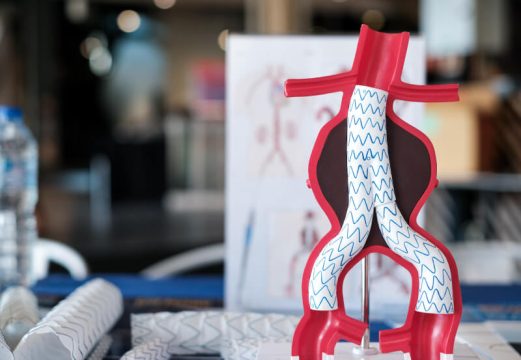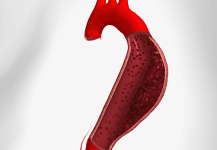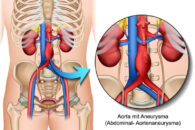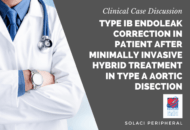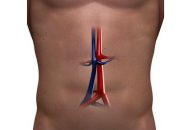Intramural hematoma (IMH) is considered a subtype of acute aortic syndrome (AAS), and some authors describe it as a developmental stage that might cause high morbimortality events such as dissection, aneurysm, or aortic rupture. One of the CT findings associated with IMH is focal contrast enhancement (FCE) within the intramural hematoma, with a reported incidence…
SOLACI-SBHCI 2023 | AORTIC ANEURYSM FROM THE GUIDELINES TO THE REAL WORLD – Dr. Felix Damas de los Santos
Read the most outstanding articles from SOLACI-SBHCI 2023 Congress. In this case, check the presentation by Dr. Felix Damas de los Santos, entitled “Alternative Vascular Access for Structural Heart Interventions”
SAFE-AAA: Are the New Endologix Devices for Abdominal Aortic Aneurysm Safe? 3-Year Followup
New unibody endologix endografts for the endovascular repair of abdominal aortic aneurysm 3-4-year safety followup At present, we have seen endovascular intervention of abdominal aortic aneurysm (EVAR) increase over surgical repair. However, the procedure is not free from complications, endoleak being the most frequent. Indeed, according to different series, it has a 20-25% incidence in AAA. Most…
Uncomplicated Type B Aortic Dissection
Mortality Assessment, Interventions and Hospitalization in Patients with Uncomplicated Type B Aortic Dissection with TEVAR. Over 60% of type b aortic dissections present with no complications, such as signs of imminent rupture or already established poor perfusion. Most uncomplicated type b aortic dissections (uTBAD) are managed with medical treatment to control pain and limit the…
Intervention in Patients with Takayasu Arteritis: Rescue Therapy or an Alternative Complementary to Immunosuppressive Therapy?
Takayasu arteritis (TAK) is an uncommon granulomatous large-vessel vasculitis that affects the aorta and its primary branches. The most frequently types of observed vascular compromise are obstructive lesions, and aneurysmal vascular lesions or dissections. In 2021, the American College of Rheumatology recommended not to implement percutaneous intervention (PI) with these patients and only use immunosuppressive…
Management of Abdominal Aortic Aneurysms in 2021
Abdominal aortic aneurysms (AAA) are those of >3 cm aortic diameter. They run the risk of rupture and ensuing death by bleeding. In consequence, they are treated to repair the aneurysm before it ruptures. In this regard, the most relevant predictor of rupture is aneurysm diameter. That is, the greater the aneurysm, the greater the…
Fenestrated Endografts as Treatment for Type I Endoleak: What is the Price of Success?
Both fenestrated and branched endografts are effective to treat patients after failure of their initial endograft due to significant type I endoleak. This situation is costly both because of the devices themselves, and also due to the several endovascular and surgical procedures required. Failure of an endograft to treat an infrarenal abdominal aortic aneurysm due to…
SOLACI PERIPHERAL | Type Ib Endoleak Correction in Patient After Minimally Invasive Hybrid Treatment in Type A Aortic Disection
Here is a new SOLACI PERIPHERAL Case! In this opportunity, Dr. Daniel Zanuttini (Arg.) presents “Type Ib Endoleak Correction in Patient After Minimally Invasive Hybrid Treatment in Type A Aortic Disection”. This is the 8th clinical case presented by SOLACI Peripheral. The purpose of this space is to encourage and further the exchange of experiences…
Abdominal Aortic Aneurysm during the Pandemic: Should They Be Operated or Deferred?
Some European societies have recommended deferring the treatment of infrarenal abdominal aortic aneurysm (AAA) ≥5.5 cm during the COVID-19 pandemic. However, these documents have also suggested optimal deferral times, and everything must be adjusted according to the transmission risk/risk of rupture balance. Annual risk of rupture can be estimated based on a prospective cohort published by…
Which Type 2 Endoleaks Should We Intervene?
This work emphasizes the need to be conservative with type 2 endoleaks, and the need for long-term prospective information to learn about the advantages of intervention. The presence of type 2 endoleaks is associated with reintervention, as it was historically assumed that they increase the risk of sac rupture. However, this new research, published in…
Contralateral Occluded Carotid Defines Revascularization Strategy
A significative lesion to the carotid artery in addition to contralateral carotid occlusion is an obvious factor of high risk for a revascularization procedure. However, this might be true for surgery but not for carotid artery stenting according to this recent publication in JACC. The presence of contralateral carotid occlusion has been established as high…
